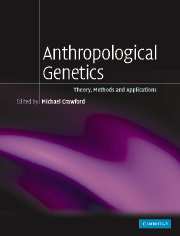Book contents
- Frontmatter
- Contents
- List of Contributors
- Preface
- Chapter 1 Foundations of Anthropological Genetics
- Part 1 Theory
- Part 2 Methods
- Part 3 General Applications
- Chapter 9 Applications of Molecular Genetics to Forensic Sciences
- Chapter 10 Emerging Technologies: The Bright Future of Fluorescence
- Chapter 11 Mapping Genes Influencing Human Quantitative Trait Variation
- Part 4 Part IV The Human Diaspora
- Index
- References
Chapter 9 - Applications of Molecular Genetics to Forensic Sciences
Published online by Cambridge University Press: 05 June 2012
- Frontmatter
- Contents
- List of Contributors
- Preface
- Chapter 1 Foundations of Anthropological Genetics
- Part 1 Theory
- Part 2 Methods
- Part 3 General Applications
- Chapter 9 Applications of Molecular Genetics to Forensic Sciences
- Chapter 10 Emerging Technologies: The Bright Future of Fluorescence
- Chapter 11 Mapping Genes Influencing Human Quantitative Trait Variation
- Part 4 Part IV The Human Diaspora
- Index
- References
Summary
Introduction
There are many parallels between anthropological genetics and forensic science. Both have evolved as new useful human polymorphisms were found. Both have evolved as technology has advanced. See the excellent coverage of this in Chapter 7. The approaches of anthropological genetics to the study of human populations is described in Chapter 7. In contrast to anthropological genetics which usually looks at the population, forensic science uses the genetically useful markers found in populations to characterize or in forensic terminology ‘individualize’ evidence and individuals. In the ideal sense both would like to have genetic markers that will either individualize populations or evidence to a given population of geographical origin. In forensic science the area that tests biological testing of evidence is called forensic genetics. In forensic genetics there are two general ways in which evidence is individualized. The first is done by direct comparison of two genetic profiles; the second is done using Mendelian inheritance to establish the genetic relationship.
Forensic science uses a process of comparison in which an unknown sample is always compared to a known or reference sample. In the case of identification of drugs a white powder suspected of being a controlled substance is seized by a police officer and submitted to the crime laboratory for identification. The laboratory will do a presumptive test to see if the powder could be a controlled substance.
- Type
- Chapter
- Information
- Anthropological GeneticsTheory, Methods and Applications, pp. 235 - 276Publisher: Cambridge University PressPrint publication year: 2006



